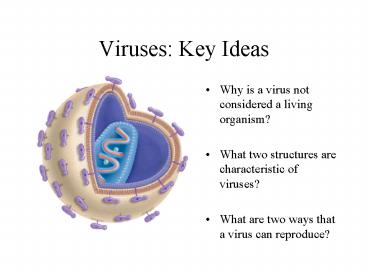Viruses: Key Ideas - PowerPoint PPT Presentation
Title:
Viruses: Key Ideas
Description:
Tobacco Mosaic Virus Enteroviruses cause many common illnesses such as polio, ... The virus destroys the host DNA and uses the cell s materials to create new ... – PowerPoint PPT presentation
Number of Views:289
Avg rating:3.0/5.0
Title: Viruses: Key Ideas
1
Viruses Key Ideas
- Why is a virus not considered a living organism?
- What two structures are characteristic of
viruses? - What are two ways that a virus can reproduce?
2
Is a Virus Alive?
- Viruses are not considered living because they
are missing key characteristics of living
organisms. - Viruses do have genetic material, but they cannot
reproduce on their own. - Viruses reproduce by infecting cells. Viruses use
the cells ribosomes, ATP, enzymes, and other
molecules to make more viruses.
3
Is a Virus Alive?, continued
- Viruses do not grow. Instead, they are assembled
into their full size within a cell. - Viruses do not carry out any metabolic
activities, do not have any cytoplasm or
organelles, and do not maintain homeostasis.
4
Viral Structure
- The structure of a virus is relatively simple
with two structures that are characteristic of
all viruses. - All viruses have nucleic acid (either DNA or RNA)
and a capsid. A capsid is a protein covering that
surrounds the nucleic acid core in a virus. - In addition to a capsid, viruses may have an
envelope. An envelope is a membranelike layer
(made from the membrane of the host cell) that
covers the capsid of some viruses. - Viruses that infect bacteria also have tail
fibers.
5
Types of Viruses
6
Plant Viruses They are similar to animal viruses
in most basic characteristics but they can also
be markedly different. Most plant viruses have
RNA as the genetic material.
Tobacco Mosaic Virus
7
Enteroviruses cause many common illnesses such
as polio, meningitis, encephalitis, common cold,
and tonsillitis,
8
Rotavirus Viral gastroenteritis is the second
most common clinical disease in developed
countries
9
Bacteriophages viruses that attack bacteria
10
Virus Reproduction
- A viral infection begins when the genetic
material of a virus enters a host cell. - Once inside the cell, a virus can reproduce by
two different processes. - Viruses can reproduce by a lytic life cycle and a
lysogenic life cycle.
11
The Lytic and Lysogenic Life Cycle
12
Lytic cycle
- Virus attaches to receptors on host cell and
injects its genetic material into the cell. - The virus destroys the host DNA and uses the
cells materials to create new viruses (100
200) - The host cell splits open and the viruses are
released. - These viruses will infect new cells.
- Viruses that reproduce by the lytic cycle are
called virulent viruses.
13
Lysogenic cycle
- The virus injects its genetic material into the
host cell. The viral DNA is incorporated into
the DNA of the cell (called prophage). - Whenever the cell divides, the viral DNA is
copied along with the cell DNA. This may
continue for months or years. - At some point, a trigger (such as stress or
weakened immune system) may cause the virus to
leave the lysogenic cycle and enter the lytic
cycle, destroying the host cell. - A virus that reproduces in this way is called a
temperate virus.
14
Task
- 1) Sketch and label a typical virus (p 476 or 477
your choice). Label DNA/RNA, capsid, envelope
(if present), glycoprotein (if present, tail
fibers (if present) - 2) Sketch lytic and lysogenic reproductive cycles
(p 478). Label lytic cycle (on left) and
lysogenic cycle (on right). Describe each stage.































